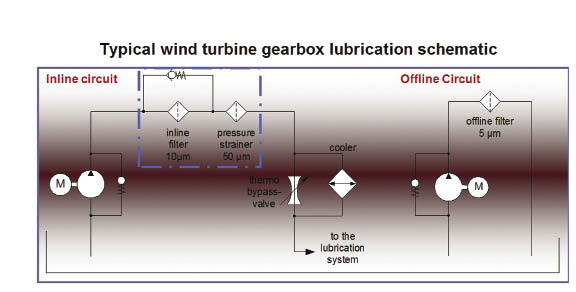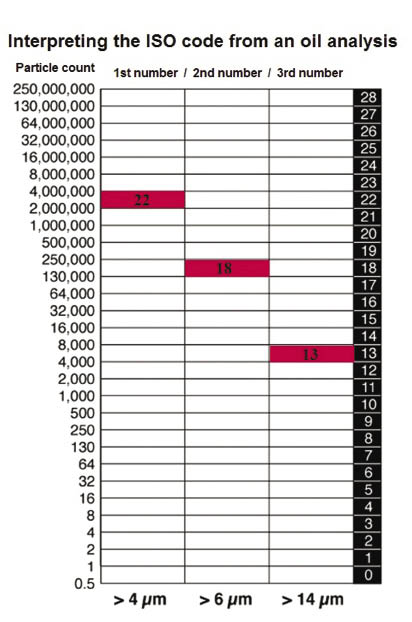
The cut away shows a little internal detail of a typical two stage, gearbox-oil filter. Such units weigh about 20 lb empty.
Filters and breathers on wind-turbine gearboxes must work under conditions found in no other industrial setting. Gearbox oil, for instance, undergoes large viscosity changes due to a wide temperature span and operating conditions. And then there is potential for a high water content in the oil from humidity and condensation. “Most current maintenance practices are OEM specified, but as units come out of warranty, their owners are driving for more industry standards and specs,” says HYDAC Technology Corporation’s Meagan Santos. The sales engineer made these comments during the recent WindTech 2012 event in Sweetwater, Texas, and provides them as guidelines for O&M techs and system designers regarding care and maintenance of this lubrication equipment.
For instance, Santos says that gearbox breathers are a first line of defense against airborne contaminants. “The devices let the gearbox take in air as it cools while filtering water vapor and solid contaminants before they enter the fluid system. When gearboxes warm up, breathers should let air escape while keeping oil mist and splash inside.” When a breather blocks up, the pressure differentials in a warming gearbox can push oil out its labyrinth seals and onto nacelle floors.

The typical lubrication schematic for a multi-megawatt wind turbine is suggested by AGMA 6006. The offline circuit to the right is for a separate pump and filter unit that may be connected to remove smaller particles, or water, or both. AGMA 6006 and ISO 4406 suggest an oil cleanliness requirement of -/16/13. The lube circuit should be capable of maintaining these values.
Filters, of course, remove particulate matter from the lubricating oil, to a degree. “On a two-stage filter from our company, for example, the first stage removes debris 10 µm and larger while the second catches particles 50 µm and larger. On cold startups when the oil is thick and slow to move, a valve lets the oil bypass the 10 µm filter. Generally, the flow rate and oil temperature, often 10 to 30°C, governs when the bypass valve begins closing for finer filtering.” The springs on bypass valves vary but a common setting is for about 4 bar (about 59 psi). The main filter, the outer portion with the pass protection, handles the bulk of the oil flow.
Santos points out that the pump motor on the oil line often has two speeds. It runs at low speed till the oil temperature reaches about 30 to 35°C and then increases to high speed. OEMs often adjust the switchover conditions. “On occasion, someone may decide that the oil should run cooler, so they switch the pump speed to the higher setting. But what that can do is increase the pressure and bypass the 10 µm filter when oil should be going through it. That is not good.”

An oil analysis will include an ISO code of three numbers that describe the quantity of particulate contamination, such as 22/18/13. Decoding the middle number 18, for example, tells that there are between 130,000 and 250,000 particles larger than 6 µm.
Most gearboxes include a cooling circuit that typically passes oil through an air-to-oil heat exchanger. “There is always oil in the heat exchanger, even during cold ambient conditions we want some oil passing through the cooler to prevent freezing. This is similar to leaving a faucet dripping in freezing weather. In our example system, normal oil flow is to both the gearbox lube system and the cooler, starting at 45°C, the thermal valve begins to shut off flow to the gearbox, forcing oil flow through the cooler before proceeding to the gearbox lube system.”
Before topping off a gearbox, says Santos, make sure it needs oil. The standard recommended oil level is half way between min and max in the sight glass. So wait about 30 min after shutdown before reading the oil level. It takes time for the oil to settle and pour out of the cooler. It has small passages for oil and passages for air. “You can’t see through it because it’s a convoluted path to generate turbulence and good heat transfer. So it takes a long time for oil to drain out,” she says.
On occasion, the wind tech should remove about 100 to 120 ml of oil from the gearbox for laboratory analysis. A report will come back with a variety of information, one being the amount of particulate in the oil. An ISO code provides a count for three particulate levels: those larger than 4 µm across, larger than 6 µm, and larger than 14 µm. For example, consider a count on a report of 22/18/13. The accompanying table quantifies each value. (AGMA does not quantify this first value in the three, hence the dashes in their figures.) For the example, the 22 means the oil sample held between 2 million and 4 million particles greater than 4 µm across. A complete analysis report also details the chemicals in the oil sample. Companies can request a particular cleanliness level in delivered new oil.
When changing filters, says Santos, you won’t need a big wrench to complete the job. “Just hand tighten the filter-housing lid until it is snug and then back off ¼ turn,” she adds. Some O&M teams do change its O-ring as a matter of course. But there is a tendency to tighten the filter-housing lid as much as possible and that can damage the O-ring.
Water may be a problem and can be removed with temporary offline filters. Santos also cautions that there are small filters and breathers in the brake and hydraulic systems that are often overlooked. Those should be changed on OEM requirements. WPE
A few maintenance strategies

The gearbox breather, from HYDAC includes a desiccant that absorbs water vapor. The material changes color to tell it needs changing.
Although there are more, HYDAC’s Meagan Santos suggests these gearbox maintenance strategies.
• Don’t underestimate the importance of breathers
• Take a proper oil sample of 50 to 100 ml. Labs can provide guidance.
• Use wind-energy specific oil analysis labs and make sure they know the sample comes from a wind turbine. Otherwise, they treat it differently.
• When the lab returns a report, take action guided by the oil’s condition.
• Maintain the correct oil level in the gearbox and hydraulic power unit.
• Follow proper filter changing procedures.

The table comes from the American Gear Manufacturers Assn Standard for Design and Specification of Gearboxes for Wind Turbines. The values in the last line, – /16/13, are also the ISO 4406 targets for cleanliness.
Filed Under: Featured, Hydraulics, Lubricants, News, O&M




